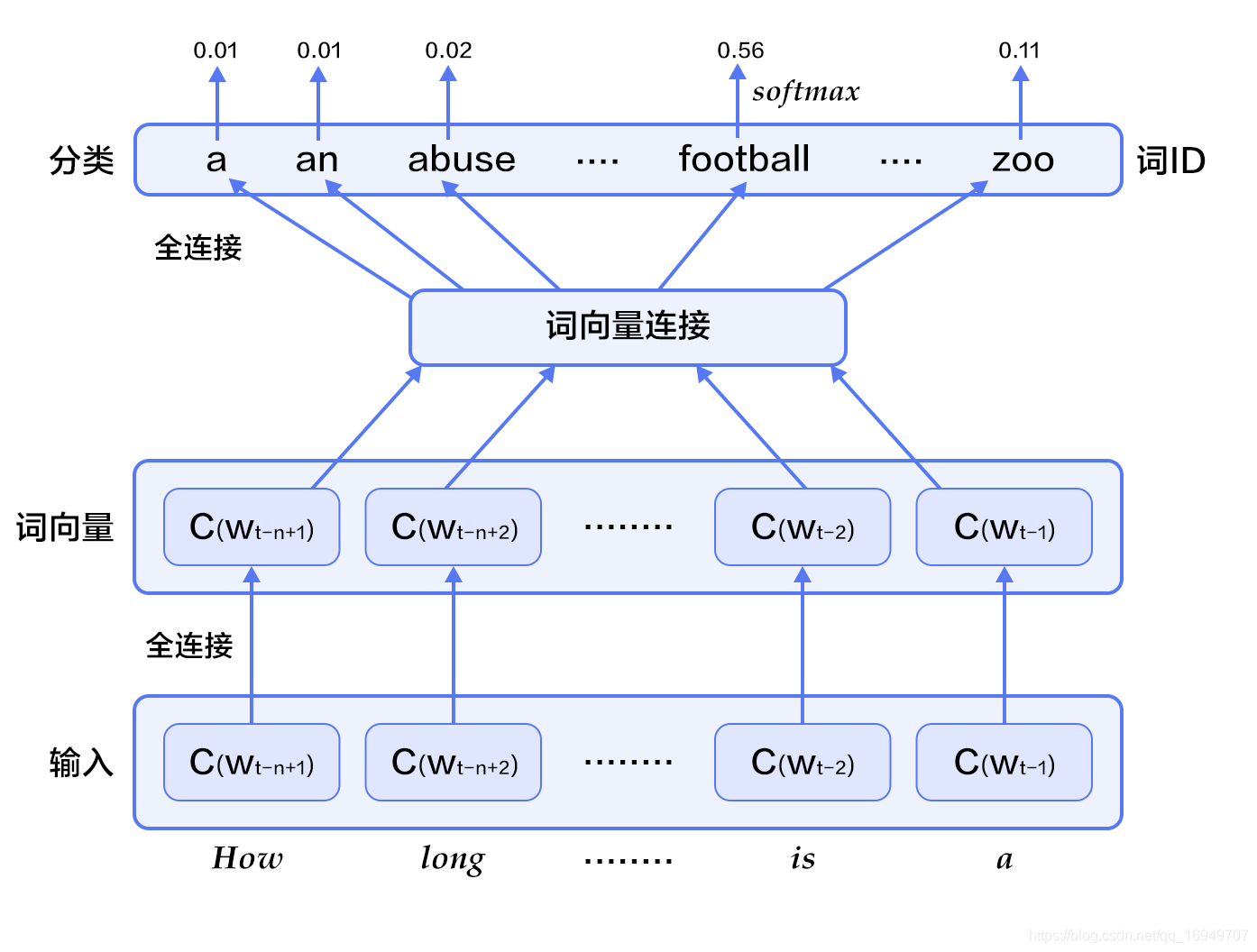1 链接
https://www.paddlepaddle.org.cn/documentation/docs/zh/1.5/beginners_guide/basics/word2vec/index.html
github源码链接:
https://github.com/PaddlePaddle/book/blob/develop/04.word2vec/train.py
PaddlePaddle Models模型库:
https://www.paddlepaddle.org.cn/documentation/docs/zh/1.5/user_guides/models/index_cn.html
2 思路

先提供一个word_dict,这个字典里面存的是每个字对应的id,然后按上图的网络来训练,输入是前四个字,预测后一个字是啥。
文中给的inference是预测下一个词,那每个字的embedding如何得到呢?不知道如何从保存的param中直接得到,我参考了原始的inference写了一个embedding的inference。
但是好像有问题,提了一个issues
https://github.com/PaddlePaddle/book/issues/783
#coding:utf-8
from __future__ import print_function
import paddle as paddle
import paddle.fluid as fluid
import six
import numpy
import math
import sys
EMBED_SIZE = 32 # embedding维度
HIDDEN_SIZE = 256 # 隐层大小
N = 5 # ngram大小,这里固定取5
BATCH_SIZE = 100 # batch大小
PASS_NUM = 100 # 训练轮数
use_cuda = False # 如果用GPU训练,则设置为True
word_dict = paddle.dataset.imikolov.build_dict()
dict_size = len(word_dict)
def inference_program(words, is_sparse):
embed_first = fluid.layers.embedding(
input=words[0],
size=[dict_size, EMBED_SIZE],
dtype='float32',
is_sparse=is_sparse,
param_attr='shared_w')
embed_second = fluid.layers.embedding(
input=words[1],
size=[dict_size, EMBED_SIZE],
dtype='float32',
is_sparse=is_sparse,
param_attr='shared_w')
embed_third = fluid.layers.embedding(
input=words[2],
size=[dict_size, EMBED_SIZE],
dtype='float32',
is_sparse=is_sparse,
param_attr='shared_w')
embed_fourth = fluid.layers.embedding(
input=words[3],
size=[dict_size, EMBED_SIZE],
dtype='float32',
is_sparse=is_sparse,
param_attr='shared_w')
concat_embed = fluid.layers.concat(
input=[embed_first, embed_second, embed_third, embed_fourth], axis=1)
hidden1 = fluid.layers.fc(input=concat_embed,
size=HIDDEN_SIZE,
act='sigmoid')
predict_word = fluid.layers.fc(input=hidden1, size=dict_size, act='softmax')
return predict_word,embed_first
def train_program(predict_word):
# 'next_word'的定义必须要在inference_program的声明之后,
# 否则train program输入数据的顺序就变成了[next_word, firstw, secondw,
# thirdw, fourthw], 这是不正确的.
next_word = fluid.layers.data(name='nextw', shape=[1], dtype='int64')
cost = fluid.layers.cross_entropy(input=predict_word, label=next_word)
avg_cost = fluid.layers.mean(cost)
return avg_cost
def optimizer_func():
return fluid.optimizer.AdagradOptimizer(
learning_rate=3e-3,
regularization=fluid.regularizer.L2DecayRegularizer(8e-4))
def train(if_use_cuda, params_dirname, embedding_params_dirname, is_sparse=True):
place = fluid.CUDAPlace(0) if if_use_cuda else fluid.CPUPlace()
train_reader = paddle.batch(
paddle.dataset.imikolov.train(word_dict, N), BATCH_SIZE)
test_reader = paddle.batch(
paddle.dataset.imikolov.test(word_dict, N), BATCH_SIZE)
first_word = fluid.layers.data(name='firstw', shape=[1], dtype='int64')
second_word = fluid.layers.data(name='secondw', shape=[1], dtype='int64')
third_word = fluid.layers.data(name='thirdw', shape=[1], dtype='int64')
forth_word = fluid.layers.data(name='fourthw', shape=[1], dtype='int64')
next_word = fluid.layers.data(name='nextw', shape=[1], dtype='int64')
word_list = [first_word, second_word, third_word, forth_word, next_word]
feed_order = ['firstw', 'secondw', 'thirdw', 'fourthw', 'nextw']
main_program = fluid.default_main_program()
star_program = fluid.default_startup_program()
predict_word, embed_first = inference_program(word_list, is_sparse)
avg_cost = train_program(predict_word)
test_program = main_program.clone(for_test=True)
sgd_optimizer = optimizer_func()
sgd_optimizer.minimize(avg_cost)
exe = fluid.Executor(place)
def train_test(program, reader):
count = 0
feed_var_list = [
program.global_block().var(var_name) for var_name in feed_order
]
feeder_test = fluid.DataFeeder(feed_list=feed_var_list, place=place)
test_exe = fluid.Executor(place)
accumulated = len([avg_cost]) * [0]
for test_data in reader():
avg_cost_np = test_exe.run(
program=program,
feed=feeder_test.feed(test_data),
fetch_list=[avg_cost])
accumulated = [
x[0] + x[1][0] for x in zip(accumulated, avg_cost_np)
]
count += 1
return [x / count for x in accumulated]
def train_loop():
step = 0
feed_var_list_loop = [
main_program.global_block().var(var_name) for var_name in feed_order
]
feeder = fluid.DataFeeder(feed_list=feed_var_list_loop, place=place)
exe.run(star_program)
for pass_id in range(PASS_NUM):
for data in train_reader():
avg_cost_np = exe.run(
main_program, feed=feeder.feed(data), fetch_list=[avg_cost])
if step % 10 == 0:
outs = train_test(test_program, test_reader)
print("Step %d: Average Cost %f" % (step, outs[0]))
# 整个训练过程要花费几个小时,如果平均损失低于5.8,
# 我们就认为模型已经达到很好的效果可以停止训练了。
# 注意5.8是一个相对较高的值,为了获取更好的模型,可以将
# 这里的阈值设为3.5,但训练时间也会更长。
if outs[0] < 5.8:
if params_dirname is not None:
fluid.io.save_inference_model(params_dirname, [
'firstw', 'secondw', 'thirdw', 'fourthw'
], [predict_word], exe)
# 保存embedding参数
if embedding_params_dirname is not None:
fluid.io.save_inference_model(embedding_params_dirname, [
'firstw', 'secondw', 'thirdw', 'fourthw'
], [embed_first], exe)
return
step += 1
if math.isnan(float(avg_cost_np[0])):
sys.exit("got NaN loss, training failed.")
raise AssertionError("Cost is too large {0:2.2}".format(avg_cost_np[0]))
train_loop()
def infer(use_cuda, params_dirname=None):
place = fluid.CUDAPlace(0) if use_cuda else fluid.CPUPlace()
exe = fluid.Executor(place)
inference_scope = fluid.core.Scope()
with fluid.scope_guard(inference_scope):
# 使用fluid.io.load_inference_model获取inference program,
# feed变量的名称feed_target_names和从scope中fetch的对象fetch_targets
[inferencer, feed_target_names,
fetch_targets] = fluid.io.load_inference_model(params_dirname, exe)
# 设置输入,用四个LoDTensor来表示4个词语。这里每个词都是一个id,
# 用来查询embedding表获取对应的词向量,因此其形状大小是[1]。
# recursive_sequence_lengths设置的是基于长度的LoD,因此都应该设为[[1]]
# 注意recursive_sequence_lengths是列表的列表
data1 = numpy.asarray([[211]], dtype=numpy.int64) # 'among'
data2 = numpy.asarray([[6]], dtype=numpy.int64) # 'a'
data3 = numpy.asarray([[96]], dtype=numpy.int64) # 'group'
data4 = numpy.asarray([[4]], dtype=numpy.int64) # 'of'
lod = numpy.asarray([[1]], dtype=numpy.int64)
first_word = fluid.create_lod_tensor(data1, lod, place)
second_word = fluid.create_lod_tensor(data2, lod, place)
third_word = fluid.create_lod_tensor(data3, lod, place)
fourth_word = fluid.create_lod_tensor(data4, lod, place)
assert feed_target_names[0] == 'firstw'
assert feed_target_names[1] == 'secondw'
assert feed_target_names[2] == 'thirdw'
assert feed_target_names[3] == 'fourthw'
# 构造feed词典 {feed_target_name: feed_target_data}
# 预测结果包含在results之中
results = exe.run(
inferencer,
feed={
feed_target_names[0]: first_word,
feed_target_names[1]: second_word,
feed_target_names[2]: third_word,
feed_target_names[3]: fourth_word
},
fetch_list=fetch_targets,
return_numpy=False)
print(numpy.array(results[0]))
print('next word results[0]:',numpy.array(results[0]))
print('next word results[0].shape:',numpy.array(results[0]).shape)
most_possible_word_index = numpy.argmax(results[0])
print(most_possible_word_index)
print([
key for key, value in six.iteritems(word_dict)
if value == most_possible_word_index
][0])
def embedding_infer(use_cuda, embedding_params_dirname=None):
place = fluid.CUDAPlace(0) if use_cuda else fluid.CPUPlace()
exe = fluid.Executor(place)
inference_scope = fluid.core.Scope()
with fluid.scope_guard(inference_scope):
# 使用fluid.io.load_inference_model获取inference program,
# feed变量的名称feed_target_names和从scope中fetch的对象fetch_targets
[inferencer, feed_target_names,
fetch_targets] = fluid.io.load_inference_model(embedding_params_dirname, exe)
# 设置输入,用四个LoDTensor来表示4个词语。这里每个词都是一个id,
# 用来查询embedding表获取对应的词向量,因此其形状大小是[1]。
# recursive_sequence_lengths设置的是基于长度的LoD,因此都应该设为[[1]]
# 注意recursive_sequence_lengths是列表的列表
data1 = numpy.asarray([[211]], dtype=numpy.int64) # 'among'
data2 = numpy.asarray([[6]], dtype=numpy.int64) # 'a'
data3 = numpy.asarray([[96]], dtype=numpy.int64) # 'group'
data4 = numpy.asarray([[4]], dtype=numpy.int64) # 'of'
lod = numpy.asarray([[1]], dtype=numpy.int64)
first_word = fluid.create_lod_tensor(data1, lod, place)
second_word = fluid.create_lod_tensor(data2, lod, place)
third_word = fluid.create_lod_tensor(data3, lod, place)
fourth_word = fluid.create_lod_tensor(data4, lod, place)
assert feed_target_names[0] == 'firstw'
assert feed_target_names[1] == 'secondw'
assert feed_target_names[2] == 'thirdw'
assert feed_target_names[3] == 'fourthw'
# 构造feed词典 {feed_target_name: feed_target_data}
# 预测结果包含在results之中
print(feed_target_names)
results = exe.run(
inferencer,
feed={
feed_target_names[0]: first_word,
feed_target_names[1]: second_word,
feed_target_names[2]: third_word,
feed_target_names[3]: fourth_word
},
# feed={
# feed_target_names[0]: data1,
# feed_target_names[1]: data2,
# feed_target_names[2]: data3,
# feed_target_names[3]: data4
# },
fetch_list=fetch_targets,
return_numpy=False)
print( word embedding results[0]:',numpy.array(results[0]))
print( word embedding results[0].shape:',numpy.array(results[0]).shape)
def main(use_cuda, is_sparse):
if use_cuda and not fluid.core.is_compiled_with_cuda():
return
params_dirname = "word2vec.inference.model"
embedding_params_dirname = "word2vec.embedding.inference.model"
train(
if_use_cuda=use_cuda,
params_dirname=params_dirname,
embedding_params_dirname=embedding_params_dirname,
is_sparse=is_sparse)
infer(use_cuda=use_cuda, params_dirname=params_dirname)
embedding_infer(use_cuda=use_cuda,embedding_params_dirname=embedding_params_dirname)
main(use_cuda=use_cuda, is_sparse=True)
output:
Step 0: Average Cost 7.377010
Step 10: Average Cost 6.168406
Step 20: Average Cost 5.790505
[[0.02989654 0.03431715 0.00012712 ... 0.00019843 0.00016911 0.02760296]]
next word results[0]: [[0.02989654 0.03431715 0.00012712 ... 0.00019843 0.00016911 0.02760296]]
next word results[0].shape: (1, 2073)
1
<e>
[u'firstw', u'secondw', u'thirdw', u'fourthw']
word embedding results[0]: [[0.02989654 0.03431715 0.00012712 ... 0.00019843 0.00016911 0.02760296]]
word embedding results[0].shape: (1, 2073)











 本文介绍如何使用PaddlePaddle构建词向量模型,通过实例演示模型训练流程,包括定义网络结构、训练过程及如何进行预测。文章详细展示了如何通过n-gram预测下一个词,并提供了获取词嵌入向量的方法。
本文介绍如何使用PaddlePaddle构建词向量模型,通过实例演示模型训练流程,包括定义网络结构、训练过程及如何进行预测。文章详细展示了如何通过n-gram预测下一个词,并提供了获取词嵌入向量的方法。
















 2700
2700

 被折叠的 条评论
为什么被折叠?
被折叠的 条评论
为什么被折叠?








